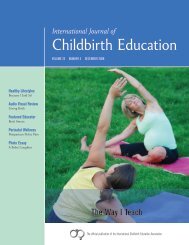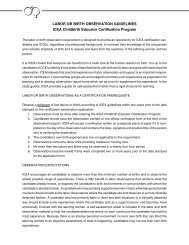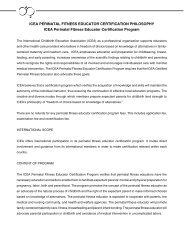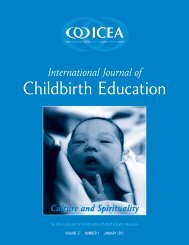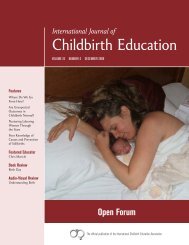JOURNAL - International Childbirth Education Association
JOURNAL - International Childbirth Education Association
JOURNAL - International Childbirth Education Association
Create successful ePaper yourself
Turn your PDF publications into a flip-book with our unique Google optimized e-Paper software.
STATIS-<br />
by Dale King<br />
Teenage Pregnancy<br />
A recent report from the Center for Disease Control and<br />
Prevention (1998) indicates that teenage pregnancy in<br />
the United States has decreased since the beginning of<br />
the 1990s. The 1996 birth rate among teenage mothers,<br />
the number of births per 1,000 teenage women, fell 3<br />
to 8% depending on the age specific subgroup. Among<br />
teenage women 15 to 19 years of age, the 1996 birth rate<br />
fell 4% from the previous year and 12% from 1991. The<br />
decline in the American teenage birth rate was pervasive,<br />
occurring in all of the fifty states, the Virgin Islands, and<br />
the District of Columbia. In only three states, Delaware,<br />
Rhode Island, and North Dakota, was the decline statistically<br />
insignificant. This decline follows the sharp increase<br />
in the birth rate that occurred from 1986 to 1991 when<br />
the teenage birth rate increased 24%.<br />
Between 1995 and 1996, teenage birth rates declined<br />
for all racial and ethnic groups with the exception of the<br />
Cuban teenage birth rate which increased from 29.2 to<br />
34.0 births per 1,000 Cuban teenage women. The greatest<br />
decline from 1991 occurred among non-Hispanic black,<br />
Puerto Rican, and other Hispanic teens. These groups<br />
experienced a decline in the birth rate of approximately<br />
20%.<br />
Despite recent declines in the teenage birth rate, it<br />
is still true that more than one million teenagers in the<br />
United States become pregnant each year. In recognition<br />
of this fact, the American Academy of Pediatrics reiterated<br />
their 1989 statement on Counselling the Adolescent About<br />
Pregnancy Options (1998). The statement is intended to<br />
serve as an objective guide to the pediatrician who must<br />
diagnose and then counsel the pregnant adolescent.<br />
Counselling must be comprehensive as to the adolescent’s<br />
alternatives and throughout the counselling the pediatrician<br />
must not impose his own beliefs and values. If the<br />
pediatrician feels that he cannot objectively present an<br />
alternative to the adolescent, he should refer the adolescent<br />
to other experienced professionals. Adolescents have legal<br />
rights protecting their privacy and the pediatrician must be<br />
aware of and respect those rights. Confidentiality laws may<br />
vary depending on the locality, and the pediatrician should<br />
be informed of these laws. The law allows the pediatrician<br />
to inform the appropriate government agency when he<br />
suspects sexual abuse. Widom and Kuhns (1996) studied<br />
the impact of early childhood victimization on teenage<br />
pregnancy, subsequent prostitution, and promiscuity. Using<br />
1967 through 1971 criminal court records from a Midwest<br />
jurisdiction, the authors were able to identify 908 cases of<br />
the abuse or neglect of a child 11 years old or younger.<br />
The 908 cases of abuse or neglect were matched with a<br />
control group based on race, gender, and age. Identification<br />
of the members of the control group was achieved<br />
by reviewing county birth records. The final stage of the<br />
study, occurring as much as 20 years after the incident of<br />
abuse or neglect, was to contact and interview members<br />
of both groups to determine their subsequent sexual and<br />
obstetric history. Contrary to other studies, the authors did<br />
16 • IJCE Vol. 13 No. 4<br />
not find early childhood victimization to be a precursor<br />
to teenage pregnancy. In their concluding discussion, the<br />
authors argue that teenage pregnancy may be the result<br />
of other factors such as family size, income, and parental<br />
education and employment status. Thus, determining the<br />
factors that tend to cause teenage pregnancy depend<br />
upon the design of the study. Secondly, the authors<br />
caution that their study may underestimate the extent of<br />
teenage pregnancy since it did not include pregnancies<br />
that ended in abortion or miscarriages. The birth record<br />
data and the final interviews may not have provided this<br />
information.<br />
Brown-Peterside and Laraque (1997) describe a New<br />
York City hospital-based educational program designed<br />
to increase teenage awareness of contraception and the<br />
impact of pregnancy on the teenager’s life. The first step<br />
was to build a coalition of community groups that would<br />
serve as a working group to guide the program and<br />
sponsor a series of workshops. The workshops featured<br />
community speakers who provided neighborhood adolescents<br />
information on health-related topics. Over 1,000<br />
flyers were distributed to adolescents informing them of<br />
services provided within the hospital. A centerpiece of<br />
the program was a computer game designed to entertain<br />
and instruct the players about the realities of teenage<br />
pregnancy. Based on a questionnaire, the researchers were<br />
able to determine that 91% of the adolescents participating<br />
in the program demonstrated increased awareness of<br />
the costs of having a child and were more likely to value<br />
contraception. The working group was able to achieve<br />
sufficient success that it received the Community Access<br />
to Child Health grant to establish an adolescent health<br />
center and increase its provision of services. The Center<br />
for Disease Control and Prevention report indicates good<br />
news — teenage pregnancy is on the decline after having<br />
increased sharply. What caused the initial increase and<br />
the subsequent decline may not be completely known<br />
and will have to be left for further research. Perhaps, one<br />
way of preventing an unwanted teenage pregnancy is to<br />
educate the adolescent before she becomes sexually active.<br />
In many cases, education is the key to guiding human<br />
behavior and teenage sexuality and pregnancy may be<br />
one of these behaviors.<br />
References<br />
American Academy of Pediatrics, Committee on Adolescence. 1998.<br />
Counselling the adolescent on pregnancy options. Pediatrics 101,<br />
no. 5: 938-940.<br />
Brown-Peterside, P., and D. Laraque. 1997. Notes from the field. A<br />
community research model: A challenge to public health. American<br />
Journal Of Public Health 87, no. 9: 1563-1564.<br />
Ventura, S., J. Martin, S. Curtin, and T. Matthews. 1998. Report of final<br />
natality statistics, 1996. Monthly Vital Statistics Report 46, no. 11.<br />
Hyattsville, Maryland. National Center For Health Statistics.<br />
Widom, C., and J. Kuhn. 1996. Childhood victimization and subsequent<br />
risk for promiscuity, prostitution, and teenage pregnancy;<br />
a prospective study. American Journal Of Public Health 86, no. 11:<br />
1607-1611.



